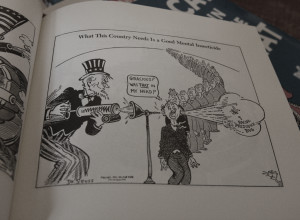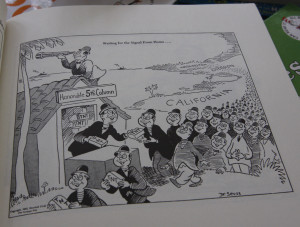Have a drink with: Dr. Seuss
Would you, could you, fight the war?
Ask him about: why Yertle the Turtle just might be Hitler.
We know Theodore Seuss Geisel as a children’s author, a playful champion of absurdity and literacy who gave us green eggs, cats in hats and an absolute lock on what to buy for the high-school graduate in your life.
Because the world seems to love nothing more than the seemingly illicit thrill of getting “secret” material from beloved authors (Harper Lee, what?), there’s been a lot of attention recently to the “new” Seuss book What Pet Should I Get?, produced from a completed manuscript and uncolored artwork found in Seuss’ personal papers.
And this is pretty exciting, particularly since the “inspired by” or “in the style of” children’s literature trend usually serves mostly to illustrate the achievement gap between authors and their posthumous copycats (Seuss and Curious George come to mind). So the thrill of new work from a master is legitimate.
But it isn’t what I love most about Dr. Seuss. That’d be the Hitler cartoons.
Dr. Seuss is without question a cultural institution. But his career is more impressive than fame alone might suggest – he was successful in a wide variety of creative work, making entirely unrelated pursuits seem not only natural but connected through his use of a consistent, instantly recognizable style and cadence. At different times Seuss was a children’s author, a cartoonist, a commercial illustrator (a vocation he shared with the similarly creative Jim Henson), a filmmaker with the likes of Chuck Jones and Frank Capra in the Army, and even a taxidermist of sorts.
What’s true of all of Dr. Seuss’ work, and what often gets lost in the onward push of generations (or efforts to adapt his work for anodyne mass media and merchandising) – is his earnest and serious pursuit of social commentary. Like Dickens (who wrote about legal reform, the Gordon Riots, economic disparity, etc.), Seuss used his art consistently to pick at social issues, without finding it necessary to sacrifice entertainment value.
To wit: his cartoons for the left-wing daily newspaper PM, a New York publication that ran during the 1940’s. PM ran no advertisements, took on weighty subjects and authors and pushed a libertarian/humanist/anti-elite social agenda perhaps best summed up, loosely, as: “if we think you’re a bully, we don’t like you.”
For years, Seuss drew pointed editorial cartoons for PM criticizing isolationism, warning in unvarnished language against complacency in the war effort and skewering Axis leadership. Running a handful of drawings each week, he produced hundreds of political cartoons, a body of work that is not only daring but sharply, carefully drawn.
Maus creator Art Spiegelman comments: “Over the past twenty to thirty years the newspaper editorial cartoon has reduced its ambition, basically becoming a gag cartoon with political subject matter. Dr. Seuss’ political cartoons were, perhaps, ahead of their time in seeking to entertain as well as convince.”
In the period before the attack on Pearl Harbor, Seuss’ cartoons for PM decried those who cautioned against U.S. involvement in what was at that point a European war. He criticized snooty isolationists, the anti-Semitism of Charles Lindbergh, and the idea that the anti-involvement cause was ignoring an inevitable, looming threat to the United States. Seuss simply seemed to feel that isolationism was, in its passivity and short-sightedness, simply un-American. One drawing from October 1941 shows a scrawny eagle, who puffs up Charles Atlas-style when he says, “I had a foul case of Appeasement…then I learned about “GUTS”…and today I feel strong enough to punch Mister Hitler right in the snoot!”

Remarkable for the era, and even now given the present focus on race, violence and fear as they have become ingrained in American identity – Seuss came out very clearly in his cartoons against anti-black racism in the U.S.:

It’s tempting to let that progressive attitude give us the warm fuzzies, yes, but neither did Seuss shy from stereotype. While his cartoons went after Axis figures individually, and made a distinction between the leaders of Germany or Italy and their people, Seuss attacked the Japanese collectively, with harsh race-based caricature that went so far as to show Japanese Americans as the dynamite-clutching “Honorable 5th Column” (and this to no complaint from readership at the time).

Nor was this the only time Seuss dealt in antiquated, racist images; some of his earlier work depicted sadly common African tribal stereotypes and minstrel caricature.
The cartoons are not Seuss’ only political works – Yertle the Turtle, largely understood as a warning against the dangers of dictatorship, was prefigured in one of Seuss’ PM cartoons (Yertle = Hitler. Who knew?). Horton Hears a Who is also generally believed to root in Seuss’ WWII experience, with elephant Horton (USA) listening to the tiny Whos (post-war Japan, now embracing democracy) declare their humanity. (Some believe the book was an effort by Seuss to atone for his prior harsh treatment of the Japanese.) And think of the Lorax’s environmental concerns, or the Butter Battle Book and nuclear politics.
And now, oh boy, my head hurts: is Seuss a well-meaning humanist, or does he tip over into liberal, paternalistic ethnocentrism? How much content can (and should) we dismiss as “of an era,” and does it detract from our enjoyment of unrelated books? Is it a disservice to just read your kid Green Eggs and Ham and want to ignore anything deeper than the rhyme scheme? (Because Seuss loved ostriching…) Does it sour our childhood heroes to find out they weren’t fully enlightened?
In the end, it isn’t that I can solve the problem – honestly, I can’t and am a little too cowardly to try. What I appreciate in the depth, the vigor and even the uncomfortably sharp edges of Seuss’ work is the complexity it lends him as an individual – the idea that a flawed individual can also be a creative one, that a surviving body of work can at the same time delight us, educate us, inspire us and remind us of where we need to improve as humans.
Seuss might in that regard agree with one of my favorite Peter Sellers lines: in the end, “to label any subject unsuitable for comedy is to admit defeat.”
Fun facts:
Seuss was born in Massachusetts to a German immigrant family, attended Dartmouth College and decided against academia after some young-life exploration (the “Dr.” title is inventive and, later, honorary). For those with concerns about purity of pursuit in the arts, Seuss’ early years – and his financial stability through the Depression – were made possible by a seventeen-year career at Esso (Standard Oil), for which he drew advertisements – notably for their “Flit” bug-spray product. In fact, for most of his life Seuss was a commercial illustrator with a sideline in children’s books.
The new book What Pet Should I Get? was released just this week. It was amusingly reviewed in the Guardian (UK):
“But most of the options, although infused with personality, are perfectly real: a dog, a cat, a rabbit, a goldfish. This makes it hard to shake off real-world questions: are goldfish and dogs really interchangeable pets? Why do the children have an ironclad deadline but no other parameters within which to make their decision? Why, twice over, are they confronted with a parade of animals marching across a dark and forbidding background waving banners that read “MAKE UP YOUR MIND”? You can’t help thinking the next stop is the pediatrician’s office for anxiety medication.”
The New York Times takes a very interesting look into Seuss’ creative life in the late 1950’s and early 60’s, and his possible reasons for holding back the manuscript. Brain Pickings wrote about it in terms of the ubiquitous modern fear of missing out (“FOMO”).
WWII was an especially fertile time for topical humor, perhaps the first era in which mass media aided and abetted satirists. Consider Disney’s award-winning Donald Duck propaganda cartoons, Spike Jones singing “Der Fuehrer’s Face,” Charlie Chaplin in The Great Dictator: there was a real movement to make tough points with humor, and to encourage a collective release of tension.
There are many fun and familiar tales about Seuss – including the famous “Green Eggs” bet that he couldn’t write a book only using 50 words…
Additional Reading:
Richard Minear, Dr. Seuss Goes to War (cartoons and Spiegelman quotes taken from here)
The Seuss cartoon archive at UCSD
How Orlo Got His Book is a fantastic column Seuss wrote for the NYT Review of Books in the 1950’s, in which he laments the overly simplistic state of children’s literature at the time.
PBS just this week, on Seuss’ detractors.
